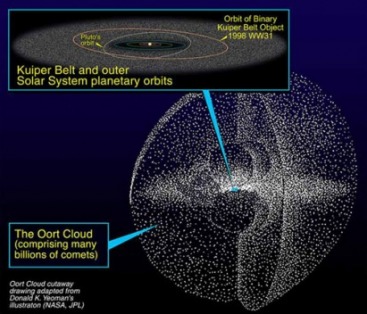Oort Cloud

The Oort cloud (pronounced /ort/ ort, alternatively the Öpik-Oort Cloud (IPA: ['øpik])) is a spherical cloud of comets believed to lie roughly 50,000AU, or nearly a light-year, from the Sun;[1] this distance places the cloud at nearly a quarter of the distance to Proxima Centauri, the nearest star to the Sun. The Kuiper belt and scattered disc, the other two known reservoirs of trans-Neptunian objects, are less than one thousandth the Oort cloud's distance. The outer extent of the Oort cloud defines the boundary of our Solar System.
The Oort cloud is thought to comprise two separate regions: a spherical outer Oort cloud and a disc-shaped inner Oort cloud, or Hills cloud. Objects in the Oort cloud are largely composed of ices such as water, ammonia and methane. Astronomers believe that the matter comprising the Oort cloud formed closer to the Sun, and was scattered far out into space by the gravitational effects of the giant planets early in the Solar System's evolution.[1]
Although no confirmed direct observations of the Oort cloud have been made, astronomers believe that it is the source of all long-period and Halley-typecomets entering the inner Solar System, and many of the Centaurs and Jupiter-family comets as well.[2] The outer Oort cloud is only loosely bound to the Solar System, and thus is easily affected by the gravitational pull both of passing stars, and of the Milky Way galaxy itself. These forces occasionally dislodge comets from their orbits within the cloud and send them towards the inner Solar System.[1] Based on their orbits, most of the short-period comets may come from the scattered disc, but some may still have originated from the Oort Cloud.[1][2] Although the Kuiper belt and the farther scattered disc have been observed and mapped, only two currently known trans-Neptunian objects, 90377 Sedna and 2000 CR105, are considered possible members of the inner Oort cloud.[3]
